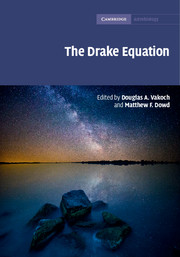Book contents
- The Drake EquationEstimating the Prevalence of Extraterrestrial Life through the Ages
- Cambridge Astrobiology
- The Drake Equation
- Copyright page
- Dedication
- Contents
- Contributors
- Foreword
- Preface
- Book part
- Introduction
- 1 Rate of formation of stars suitable for the development of intelligent life, R*, pre-1961
- 2 Rate of formation of stars suitable for the development of intelligent life, R*, 1961 to the present
- 3 Fraction of stars with planetary systems, fp, pre-1961
- 4 Fraction of stars with planetary systems, fp, 1961 to the present
- 5 Number of planets, per solar system, with an environment suitable for life, ne, pre-1961
- 6 Number of planets, per solar system, with an environment suitable for life, ne, 1961 to the present
- 7 Fraction of suitable planets on which life actually appears, fl, pre-1961
- 8 Fraction of suitable planets on which life actually appears, fl, 1961 to the present
- 9 Fraction of life-bearing planets on which intelligent life emerges, fi, pre-1961
- 10 Fraction of life-bearing planets on which intelligent life emerges, fi, 1961 to the present
- 11 Fraction of civilizations that develop a technology that releases detectable signs of their existence into space, fc, pre-1961
- 12 Fraction of civilizations that develop a technology that releases detectable signs of their existence into space, fc, 1961 to the present
- 13 Length of time such civilizations release detectable signals into space, L, pre-1961
- 14 Length of time such civilizations release detectable signals into space, L, 1961 to the present
- Afterword
- Index
- References
11 - Fraction of civilizations that develop a technology that releases detectable signs of their existence into space, fc, pre-1961
Published online by Cambridge University Press: 05 July 2015
- The Drake EquationEstimating the Prevalence of Extraterrestrial Life through the Ages
- Cambridge Astrobiology
- The Drake Equation
- Copyright page
- Dedication
- Contents
- Contributors
- Foreword
- Preface
- Book part
- Introduction
- 1 Rate of formation of stars suitable for the development of intelligent life, R*, pre-1961
- 2 Rate of formation of stars suitable for the development of intelligent life, R*, 1961 to the present
- 3 Fraction of stars with planetary systems, fp, pre-1961
- 4 Fraction of stars with planetary systems, fp, 1961 to the present
- 5 Number of planets, per solar system, with an environment suitable for life, ne, pre-1961
- 6 Number of planets, per solar system, with an environment suitable for life, ne, 1961 to the present
- 7 Fraction of suitable planets on which life actually appears, fl, pre-1961
- 8 Fraction of suitable planets on which life actually appears, fl, 1961 to the present
- 9 Fraction of life-bearing planets on which intelligent life emerges, fi, pre-1961
- 10 Fraction of life-bearing planets on which intelligent life emerges, fi, 1961 to the present
- 11 Fraction of civilizations that develop a technology that releases detectable signs of their existence into space, fc, pre-1961
- 12 Fraction of civilizations that develop a technology that releases detectable signs of their existence into space, fc, 1961 to the present
- 13 Length of time such civilizations release detectable signals into space, L, pre-1961
- 14 Length of time such civilizations release detectable signals into space, L, 1961 to the present
- Afterword
- Index
- References
Summary
This chapter examines the prehistory of the search for extraterrestrial intelligence (SETI) prior to 1961. It reviews the first attempts to contact other planets at the scale of the solar system – that is, interplanetary communication (premodern SETI era). We emphasize the latter half of the nineteenth century because many efforts were made at that time to contact our neighboring planets through interplanetary telegraphy. Such a technique became conceivable in the 1860s thanks to many advances in the field of terrestrial communication (electrical telegraphy, telephone). Generally, the pioneers in interplanetary telegraphy proposed to send flashes using powerful lamps and reflectors to reach our neighboring planets, Mars and Venus. Considering their methodology, the early proposals using light flashes could be compared to modern Active SETI, or METI (messaging to extraterrestrial intelligence). The intellectual approach is similar to that of CETI (communication with extraterrestrial intelligence), since the first attempts were expected to be a two-way exchange of information. Even though they remained only theoretical, these attempts demonstrated that basic thought about a universal language had begun as early as the 1860s. At the turn of the twentieth century, new possibilities emerged with the birth of wireless telegraphy and the development of radio techniques used for telecommunications on Earth. Listening to Mars by means of radio waves was sporadically attempted in the 1920s. By the mid-twentieth century, developments in radio astronomy had a decisive influence on the birth of SETI because they allowed astronomers to contemplate the possibility of contact with extraterrestrials at a much larger scale, that of interstellar distances.
- Type
- Chapter
- Information
- The Drake EquationEstimating the Prevalence of Extraterrestrial Life through the Ages, pp. 205 - 226Publisher: Cambridge University PressPrint publication year: 2015

